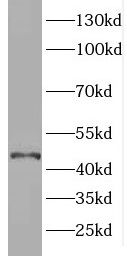Products
ELOVL6 antibody
| Synonyms: | Very long chain fatty acid elongase 6|3-keto acyl-CoA synthase ELOVL6|ELOVL fatty acid elongase 6 (ELOVL FA elongase 6)|Elongation of very long chain fatty acids protein 6|Fatty acid elongase 2 (hELO2)|Fatty acyl-CoA elongase|Long-chain fatty-acyl elongase|Very long chain 3-ketoacyl-CoA synthase 6|Very long chain 3-oxoacyl-CoA synthase 6|ELOVL6|FACE|LCE antibody | ||
| Catalogue No.: | FNab02748 | Reactivity: | Human, Mouse, Rat |
| Host: | Rabbit | Tested Application: | ELISA, WB, IHC |
| Clonality: | polyclonal | Isotype: | IgG |
| Size | Price |
|---|---|
| 100µg | Inquiry |
- SPECIFICATIONS
- FIGURES
- CONDITIONS
- FAQS
- Product Name
- ELOVL6 antibody
- Catalogue No.
- FNab02748
- Size
- 100μg
- Form
- liquid
- Purification
- Immunogen affinity purified
- Purity
- ≥95% as determined by SDS-PAGE
- Clonality
- polyclonal
- Isotype
- IgG
- Storage
- PBS with 0.02% sodium azide and 50% glycerol pH 7.3, -20℃ for 12 months(Avoid repeated freeze / thaw cycles.)
- Immunogen
- ELOVL family member 6, elongation of long chain fatty acids(FEN1/Elo2, SUR4/Elo3-like, yeast)
- Alternative Names
- Very long chain fatty acid elongase 6|3-keto acyl-CoA synthase ELOVL6|ELOVL fatty acid elongase 6 (ELOVL FA elongase 6)|Elongation of very long chain fatty acids protein 6|Fatty acid elongase 2 (hELO2)|Fatty acyl-CoA elongase|Long-chain fatty-acyl elongase|Very long chain 3-ketoacyl-CoA synthase 6|Very long chain 3-oxoacyl-CoA synthase 6|ELOVL6|FACE|LCE antibody
- UniProt ID
- Q9H5J4
- Observed MW
- 45 kDa
- Tested Applications
- ELISA, WB, IHC
- Recommended dilution
- WB: 1:500-1:2000; IHC: 1:20-1:200
 Raji cells were subjected to SDS PAGE followed by western blot with FNab02748(ELOVL6 antibody) at dilution of 1:800
Raji cells were subjected to SDS PAGE followed by western blot with FNab02748(ELOVL6 antibody) at dilution of 1:800
 Immunohistochemistry of paraffin-embedded human hepatocirrhosis using FNab02748(ELOVL6 antibody) at dilution of 1:100
Immunohistochemistry of paraffin-embedded human hepatocirrhosis using FNab02748(ELOVL6 antibody) at dilution of 1:100
- Background
- Catalyzes the first and rate-limiting reaction of the four that constitute the long-chain fatty acids elongation cycle. This endoplasmic reticulum-bound enzymatic process, allows the addition of 2 carbons to the chain of long-and very long-chain fatty acids/VLCFAs per cycle. Condensing enzyme that elongates fatty acids with 12, 14 and 16 carbons with higher activity toward C16:0 acyl-CoAs. Catalyzes the synthesis of unsaturated C16 long chain fatty acids and, to a lesser extent, C18:0 and those with low desaturation degree. May participate to the production of saturated and monounsaturated VLCFAs of different chain lengths that are involved in multiple biological processes as precursors of membrane lipids and lipid mediators.
How many times can antibodies be recycled?
First, usually it's not suggested to recycle antibodies. After use, buffer system of antibodies has changed. The storage condition of recycled antibodies for different customers also varies. Thus, the performance efficiency of recycled antibodies can’t be guaranteed. Besides, FineTest ever conducted the antibody recycling assay. Assay results show recycling times of different antibodies also varies. Usually, higher antibody titer allows more repeated use. Customers can determine based on experimental requirements.
Notes: After incubation, we recycle rest antibodies to centrifuge tube and store at 4℃. High titer antibodies can be stored for a minimum of one week. Reuse about three times.
What are components of FineTest antibody buffer?
Components of FineTest antibody buffer are usually PBS with proclin300 or sodium azide, BSA, 50% glycerol. Common preservative is proclin300 or sodium azide, which is widely applied in the lab and industry.
How about the storage temperature and duration of FineTest antibodies?
Most antibodies are stored at -20℃. Directly-labeled flow cytometry antibodies should be stored at 2 - 8℃. The shelf life is one year. If after sales issues for purchased antibodies appear, return or replacement is available. Usually, antibodies can be still used after the one-year warranty. We can offer technical support services.
Is dilution required for FineTest antibodies? What’s the dilute solution?
Directly-labeled flow cytometry antibodies are ready-to-use without dilution. Other antibodies are usually concentrated. Follow the dilution ratio suggested in the manual. Dilute solution for different experiments also varies. Common antibody dilution buffers are acceptable(e.g. PBST, TBST, antibody blocking buffer).
How to retrieve antibodies for immunohistochemistry?
Common retrieval buffers: Tris-EDTA Buffer(pH 9.0); Citrate Buffer(pH 6.0)
Heat induced antibody retrieval:
Method 1: Water-bath heating: Put the beaker with retrieval buffer and slide in the boiling water bath. Keep the boiling state for 15min. Naturally cool to room temperature;
Method 2: Microwave retrieval: Put the beaker with retrieval buffer and slide in the microwave oven. Heat at high power for 5min, Switch OFF for 3min, Heat at medium power for 5min. Naturally cool to room temperature.
How to choose secondary antibodies?
(1) Secondary antibodies react with primary antibodies. Thus, secondary antibodies should be against host species of primary antibodies. E.g. If the primary antibody is derived from rabbit, the relevant secondary antibody should be against rabbit. E.g. goat anti rabbit or donkey anti rabbit.
(2) Choose secondary antibody conjugates according to the experimental type, e.g. ELISA, WB, IHC etc. Common enzyme conjugated secondary antibodies are labelled by HRP, AP etc. Fluorescin or dye labelled secondary antibodies are applied in immunofluorescence and flow cytometry(e.g. FITC, Cy3).
